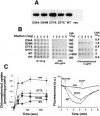No single irreplaceable acidic residues in the Escherichia coli secondary multidrug transporter MdfA
- PMID: 16855255
- PMCID: PMC1540044
- DOI: 10.1128/JB.00422-06
No single irreplaceable acidic residues in the Escherichia coli secondary multidrug transporter MdfA
Abstract
The largest family of solute transporters (major facilitator superfamily [MFS]) includes proton-motive-force-driven secondary transporters. Several characterized MFS transporters utilize essential acidic residues that play a critical role in the energy-coupling mechanism during transport. Surprisingly, we show here that no single acidic residue plays an irreplaceable role in the Escherichia coli secondary multidrug transporter MdfA.
Figures



Similar articles
-
3D model of the Escherichia coli multidrug transporter MdfA reveals an essential membrane-embedded positive charge.Biochemistry. 2005 Nov 15;44(45):14870-80. doi: 10.1021/bi051574p. Biochemistry. 2005. PMID: 16274234
-
The secondary multidrug/proton antiporter MdfA tolerates displacements of an essential negatively charged side chain.J Biol Chem. 2009 Mar 13;284(11):6966-71. doi: 10.1074/jbc.M808877200. Epub 2009 Jan 7. J Biol Chem. 2009. PMID: 19129186 Free PMC article.
-
MdfA from Escherichia coli, a model protein for studying secondary multidrug transport.J Mol Microbiol Biotechnol. 2006;11(6):308-17. doi: 10.1159/000095633. J Mol Microbiol Biotechnol. 2006. PMID: 17114895 Review.
-
The Escherichia coli multidrug transporter MdfA catalyzes both electrogenic and electroneutral transport reactions.Proc Natl Acad Sci U S A. 2003 Feb 18;100(4):1667-72. doi: 10.1073/pnas.0435544100. Epub 2003 Feb 10. Proc Natl Acad Sci U S A. 2003. PMID: 12578981 Free PMC article.
-
The fascinating but mysterious mechanistic aspects of multidrug transport by MdfA from Escherichia coli.Res Microbiol. 2018 Sep-Oct;169(7-8):455-460. doi: 10.1016/j.resmic.2017.09.004. Epub 2017 Sep 23. Res Microbiol. 2018. PMID: 28951231 Review.
Cited by
-
Outward open conformation of a Major Facilitator Superfamily multidrug/H+ antiporter provides insights into switching mechanism.Nat Commun. 2018 Oct 1;9(1):4005. doi: 10.1038/s41467-018-06306-x. Nat Commun. 2018. PMID: 30275448 Free PMC article.
-
Multicomponent drug efflux complexes: architecture and mechanism of assembly.Future Microbiol. 2009 Sep;4(7):919-32. doi: 10.2217/fmb.09.62. Future Microbiol. 2009. PMID: 19722844 Free PMC article. Review.
-
Energy coupling mechanisms of MFS transporters.Protein Sci. 2015 Oct;24(10):1560-79. doi: 10.1002/pro.2759. Epub 2015 Sep 18. Protein Sci. 2015. PMID: 26234418 Free PMC article. Review.
-
Structure and function analysis of CaMdr1p, a major facilitator superfamily antifungal efflux transporter protein of Candida albicans: identification of amino acid residues critical for drug/H+ transport.Eukaryot Cell. 2007 Mar;6(3):443-53. doi: 10.1128/EC.00315-06. Epub 2007 Jan 5. Eukaryot Cell. 2007. PMID: 17209122 Free PMC article.
-
Structural comparison of bacterial multidrug efflux pumps of the major facilitator superfamily.Trends Cell Mol Biol. 2015;10:131-140. Trends Cell Mol Biol. 2015. PMID: 27065631 Free PMC article.
References
-
- Adler, J., and E. Bibi. 2004. Determinants of substrate recognition by the Escherichia coli multidrug transporter MdfA identified on both sides of the membrane. J. Biol. Chem. 279:8957-8965. - PubMed
-
- Adler, J., and E. Bibi. 2005. Promiscuity in the geometry of electrostatic interactions between the Escherichia coli multidrug resistance transporter MdfA and cationic substrates. J. Biol. Chem. 280:2721-2729. - PubMed
-
- Adler, J., O. Lewinson, and E. Bibi. 2004. Role of a conserved membrane-embedded acidic residue in the multidrug transporter MdfA. Biochemistry 43:518-525. - PubMed
-
- Bibi, E., J. Adler, O. Lewinson, and R. Edgar. 2001. MdfA, an interesting model protein for studying multidrug transport. J. Mol. Microbiol. Biotechnol. 3:171-177. - PubMed
Publication types
MeSH terms
Substances
LinkOut - more resources
Full Text Sources
Medical
Molecular Biology Databases

